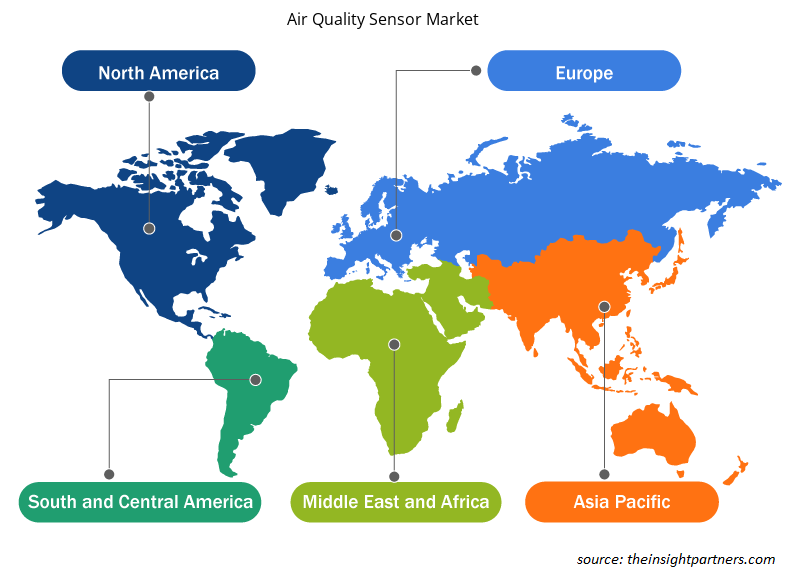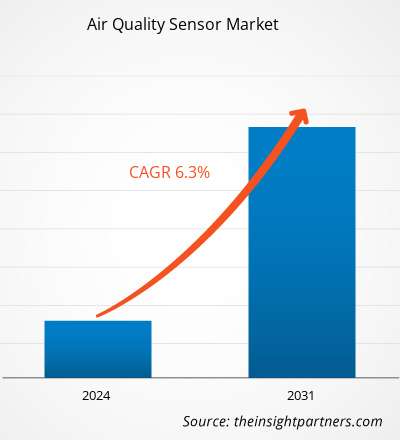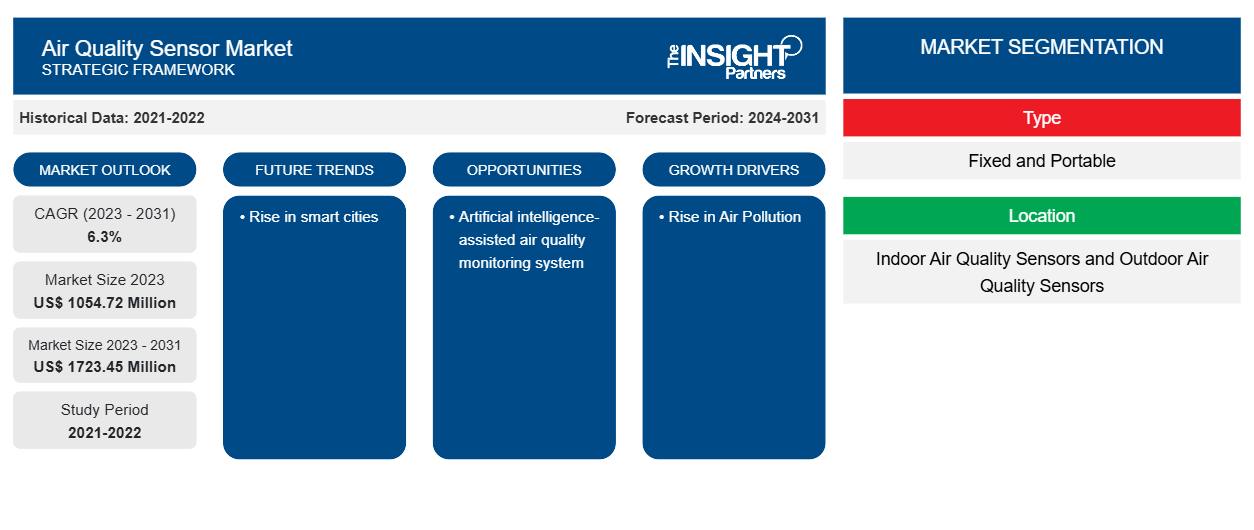Der Markt für Luftqualitätssensoren soll von 1.054,72 Millionen US-Dollar im Jahr 2023 auf 1.723,45 Millionen US-Dollar im Jahr 2031 anwachsen. Der Markt soll zwischen 2023 und 2031 eine durchschnittliche jährliche Wachstumsrate (CAGR) von 6,3 % verzeichnen. Die zunehmende Luftverschmutzung und der Fokus der Regierung auf Nachhaltigkeit dürften weiterhin die wichtigsten Trends auf dem Markt für Luftqualitätssensoren bleiben.
Marktanalyse für Luftqualitätssensoren
Die wachsenden Umweltbedenken und strengen Vorschriften der Regierung zur Überwachung der Luftqualität führen zur Einführung des Marktes für Luftqualitätssensoren. Das wachsende Bewusstsein für die Bedeutung sauberer Luft und die Nachteile von durch die Luft übertragenen Krankheiten treibt die Einführung in verschiedenen Branchen voran. Regierungsinitiativen zur Entwicklung umweltfreundlicher Industrien fördern das Marktwachstum weiter.
Marktübersicht zu Luftqualitätssensoren
Ein Luftqualitätssensor ist ein Gerät, das die Schadstoffkonzentration in der Luft misst. Er ist ein wesentlicher Bestandteil des Luftreinigers und des Frischluftsystems. Luftqualitätssensoren können normalerweise Partikel (wie PM1, PM2,5 und PM10), Gase (wie Ozon, Kohlenmonoxid, Kohlendioxid, Methan, Formaldehyd und andere) und einige Umweltindikatoren (wie Temperatur, Luftfeuchtigkeit, UV, Beleuchtung usw.) messen. Der Luftqualitätssensor erkennt Gas- und Partikelindikatoren in der Luft mithilfe optischer, elektrischer, thermischer und anderer Methoden.
Passen Sie diesen Bericht Ihren Anforderungen an
Sie erhalten kostenlos individuelle Anpassungen an jedem Bericht, einschließlich Teilen dieses Berichts oder einer Analyse auf Länderebene, eines Excel-Datenpakets sowie tolle Angebote und Rabatte für Start-ups und Universitäten.
-
Holen Sie sich die wichtigsten Markttrends aus diesem Bericht.Dieses KOSTENLOSE Beispiel umfasst eine Datenanalyse von Markttrends bis hin zu Schätzungen und Prognosen.
Markttreiber und Chancen für Luftqualitätssensoren
Anstieg der Luftverschmutzung begünstigt den Markt
Die Luftverschmutzung hat mit der zunehmenden Industrialisierung zugenommen, und auch die Schadstoffbelastung durch Feinstaub ist gestiegen. Die Regierungen mehrerer Länder haben in ihren jeweiligen Bereichen strenge Vorschriften erlassen und verschiedene Maßnahmen ergriffen, um die Luftverschmutzung durch Industrieanlagen zu verringern. Darüber hinaus installieren die Regierungen mehrerer Länder, darunter die USA, Indien und Kanada, Luftqualitätssensoren in Kraftwerken, Öl- und Gaswerken sowie in Autos, um die Schadstoffwerte zu kontrollieren und zu verfolgen. Durch die Überwachung der Luftqualität im Freien können Fabriken ihre Emissionsraten kontrollieren, indem sie den Luftqualitätsindex rund um ihre Industrieanlagen im Auge behalten.
Vorteile von Luftqualitätssensoren
Angesichts der weltweit zunehmenden Umweltbedenken besteht die Notwendigkeit, die Luftqualität kontinuierlich zu überwachen, um bestimmte Maßnahmen zu ergreifen, um ihre Auswirkungen auf die Umwelt zu minimieren. Daher nimmt die Nachfrage nach Luftqualitätssensortechnologien aufgrund der zahlreichen Vorteile, die sie bieten, zu. Sie tragen dazu bei, eine gesunde Umgebung zu schaffen, indem sie die Luftbedingungen im Innen- und Außenbereich in Echtzeit überwachen. Die Luftqualitätssensoren sind einfach zu installieren und lassen sich problemlos mit dem Mobiltelefon und dem Computer verbinden, wo sie die Ergebnisse zur Luftqualität anzeigen. Sie können eine breite Palette von Parametern wie Temperatur, Luftdruck, Luftfeuchtigkeit und mehr erfassen. Mit den kontinuierlichen technologischen Fortschritten verbessert sich die Genauigkeit dieser Sensoren, was zu ihrer Nachfrage durch mehrere Akteure in weiten Branchen wie Regierungsbehörden und akademischen Instituten, gewerblichen und privaten Nutzern, der petrochemischen Industrie, Kraftwerken , der Pharmaindustrie, Smart-City-Behörden und anderen führt. Um dieser Nachfrage gerecht zu werden, bringen Marktteilnehmer Lösungen auf den Markt, die den Markt für Luftqualitätssensoren antreiben. So brachte Vaisala im Juni 2021 einen erstklassigen Luftqualitätssensor auf den Markt, der seine Überwachungslösung ergänzt, um die Lebensqualität, Sicherheit, Effizienz und Nachhaltigkeit in Gemeinden zu verbessern.Vaisala launched a world-class air quality sensor complementing its monitoring solution to enhance quality of life, safety, efficiency, and sustainability in communities.
Segmentierungsanalyse des Marktberichts zu Luftqualitätssensoren
Wichtige Segmente, die zur Ableitung der Marktanalyse für Luftqualitätssensoren beigetragen haben, sind Typ, Standort und Endbenutzer.
- Je nach Typ ist der Markt in fest und tragbar unterteilt. Das Segment der festen Flughafengeräte hatte im Jahr 2023 einen größeren Marktanteil.
- Nach Standort ist der Markt in Sensoren für die Luftqualität in Innenräumen und Sensoren für die Luftqualität im Freien segmentiert. Das Segment der Sensoren für die Luftqualität im Freien hatte im Jahr 2023 den größten Marktanteil.
- Nach Endverbraucher ist der Markt in Regierungsbehörden und akademische Institute, gewerbliche und private Nutzer, die petrochemische Industrie, Kraftwerke, die Pharmaindustrie, Smart-City-Behörden und andere segmentiert. Das Segment Regierungsbehörden und akademische Institute hatte im Jahr 2023 den größten Marktanteil.
Marktanteilsanalyse für Luftqualitätssensoren nach geografischer Lage
Der geografische Umfang des Marktberichts für Luftqualitätssensoren ist hauptsächlich in fünf Regionen unterteilt: Nordamerika, Asien-Pazifik, Europa, Naher Osten und Afrika sowie Südamerika/Süd- und Mittelamerika.
In Bezug auf den Umsatz hatte der asiatisch-pazifische Raum im Jahr 2023 den größten Marktanteil bei Luftqualitätssensoren. Die Region besteht aus entwickelten und sich entwickelnden Volkswirtschaften wie Indien, Japan, China und anderen, was die Nachfrage nach diesen Sensoren antreibt, um eine saubere und sichere Umwelt zu gewährleisten. Das zunehmende Bewusstsein für die Vorteile der Verwendung dieser Sensoren treibt das Marktwachstum an. Darüber hinaus konzentrieren sich die Regierungsstellen in der Region auf die Entwicklung dieser Sensoren, was das Marktwachstum weiter fördert. So brachte MeitY im Januar 2023 die Technologie für ein Luftqualitätsüberwachungssystem (AI-AQMS v1.0) auf den Markt, die im Rahmen von von MeitY unterstützten Projekten entwickelt wurde. Das Centre for Development of Advanced Computing (C-DAC) in Kalkutta hat in Zusammenarbeit mit TeXMIN, ISM, Dhanbad im Rahmen des „Nationalen Programms für Elektronik- und IKT-Anwendungen in Landwirtschaft und Umwelt (AgriEnIcs)“ eine Station zur Überwachung der Luftqualität im Freien entwickelt. Ziel ist die Überwachung von Umweltschadstoffen, einschließlich Parametern wie PM 1,0, PM 2,5, PM 10,0, SO2, NO2, CO, O2, Umgebungstemperatur, relative Luftfeuchtigkeit usw., zur kontinuierlichen Analyse der Luftqualität in der Umwelt.
Regionale Einblicke in den Markt für Luftqualitätssensoren
Die regionalen Trends und Faktoren, die den Markt für Luftqualitätssensoren im gesamten Prognosezeitraum beeinflussen, wurden von den Analysten von Insight Partners ausführlich erläutert. In diesem Abschnitt werden auch Marktsegmente und Geografie für Luftqualitätssensoren in Nordamerika, Europa, im asiatisch-pazifischen Raum, im Nahen Osten und Afrika sowie in Süd- und Mittelamerika erörtert.

- Erhalten Sie regionalspezifische Daten zum Markt für Luftqualitätssensoren
Umfang des Marktberichts zu Luftqualitätssensoren
| Berichtsattribut | Details |
|---|---|
| Marktgröße im Jahr 2023 | 1054,72 Millionen US-Dollar |
| Marktgröße bis 2031 | 1723,45 Millionen US-Dollar |
| Globale CAGR (2023 - 2031) | 6,3 % |
| Historische Daten | 2021-2022 |
| Prognosezeitraum | 2024–2031 |
| Abgedeckte Segmente |
Nach Typ
|
| Abgedeckte Regionen und Länder |
Nordamerika
|
| Marktführer und wichtige Unternehmensprofile |
|
Dichte der Marktteilnehmer für Luftqualitätssensoren: Die Auswirkungen auf die Geschäftsdynamik verstehen
Der Markt für Luftqualitätssensoren wächst rasant, angetrieben durch die steigende Nachfrage der Endnutzer aufgrund von Faktoren wie sich entwickelnden Verbraucherpräferenzen, technologischen Fortschritten und einem größeren Bewusstsein für die Vorteile des Produkts. Mit steigender Nachfrage erweitern Unternehmen ihr Angebot, entwickeln Innovationen, um die Bedürfnisse der Verbraucher zu erfüllen, und nutzen neue Trends, was das Marktwachstum weiter ankurbelt.
Die Marktteilnehmerdichte bezieht sich auf die Verteilung der Firmen oder Unternehmen, die in einem bestimmten Markt oder einer bestimmten Branche tätig sind. Sie gibt an, wie viele Wettbewerber (Marktteilnehmer) in einem bestimmten Marktraum im Verhältnis zu seiner Größe oder seinem gesamten Marktwert präsent sind.
Die wichtigsten auf dem Markt für Luftqualitätssensoren tätigen Unternehmen sind:
- Energiemonitor
- Mit One Instruments
- SUEZ
- Renesas Electronics Corporation
- Winsen
- E+E
Haftungsausschluss : Die oben aufgeführten Unternehmen sind nicht in einer bestimmten Reihenfolge aufgeführt.

- Überblick über die wichtigsten Akteure auf dem Markt für Luftqualitätssensoren
Neuigkeiten und aktuelle Entwicklungen zum Markt für Luftqualitätssensoren
Der Markt für Luftqualitätssensoren wird durch die Erfassung qualitativer und quantitativer Daten nach Primär- und Sekundärforschung bewertet, die wichtige Unternehmensveröffentlichungen, Verbandsdaten und Datenbanken umfasst. Im Folgenden finden Sie eine Liste der Entwicklungen auf dem Markt:
- Im März 2024 kündigte Vaisala, ein weltweit führender Anbieter von Messinstrumenten und -informationen für den Klimaschutz, die Einführung des Air Quality Transmitter 560 (AQT560) an, des kompakten Luftqualitätssensors nach Goldstandard mit einem breiten Erfassungsbereich – PM1, PM2,5 und PM10 – und einem einzigartigen Kalibrierungssystem und Algorithmen, die eine unübertroffene Erfassungsgenauigkeit und Effizienz ermöglichen. (Quelle: Vaisala, Inc, Pressemitteilung, 2024)
- Im Januar 2024 stellte Attune, ein Branchenführer für Echtzeit-Datenlösungen, seine neueste Innovation vor: das Outdoor Air Quality (OAQ) Kit, eine sensorbasierte Plattform zur Überwachung der Luftqualität an jedem beliebigen Standort. Das OAQ Kit nutzt die UL-2905-zertifizierten Sensoren zur Überwachung der Raumluftqualität, die für den Außenbereich umfunktioniert wurden, und bietet umfassende Daten zu verschiedenen Gefahren für die Luft im Freien. Die Plug-and-Play-Technologie mit mehreren Sensoren erkennt Schadstoffe wie Temperatur, relative Luftfeuchtigkeit, flüchtige organische Verbindungen (VOCs) und Feinstaub (PM) und liefert den Betreibern wichtige Erkenntnisse für proaktive Entscheidungen. (Quelle: Attune, Pressemitteilung, 2024)
Marktbericht zu Luftqualitätssensoren – Abdeckung und Ergebnisse
Der Bericht „Marktgröße und Prognose für Luftqualitätssensoren (2021–2031)“ bietet eine detaillierte Analyse des Marktes, die die folgenden Bereiche abdeckt:
- Marktgröße und Prognose auf globaler, regionaler und Länderebene für alle wichtigen Marktsegmente, die im Rahmen des Projekts abgedeckt sind
- Marktdynamik wie Treiber, Beschränkungen und wichtige Chancen
- Wichtige Zukunftstrends
- Detaillierte PEST/Porters Five Forces- und SWOT-Analyse
- Globale und regionale Marktanalyse mit wichtigen Markttrends, wichtigen Akteuren, Vorschriften und aktuellen Marktentwicklungen
- Branchenlandschaft und Wettbewerbsanalyse, einschließlich Marktkonzentration, Heatmap-Analyse, prominenten Akteuren und aktuellen Entwicklungen
- Detaillierte Firmenprofile
- Historische Analyse (2 Jahre), Basisjahr, Prognose (7 Jahre) mit CAGR
- PEST- und SWOT-Analyse
- Marktgröße Wert/Volumen – Global, Regional, Land
- Branchen- und Wettbewerbslandschaft
- Excel-Datensatz
Aktuelle Berichte
Verwandte Berichte
Erfahrungsberichte
Grund zum Kauf
- Fundierte Entscheidungsfindung
- Marktdynamik verstehen
- Wettbewerbsanalyse
- Kundeneinblicke
- Marktprognosen
- Risikominimierung
- Strategische Planung
- Investitionsbegründung
- Identifizierung neuer Märkte
- Verbesserung von Marketingstrategien
- Steigerung der Betriebseffizienz
- Anpassung an regulatorische Trends























 Kostenlose Probe anfordern für - Markt für Luftqualitätssensoren
Kostenlose Probe anfordern für - Markt für Luftqualitätssensoren